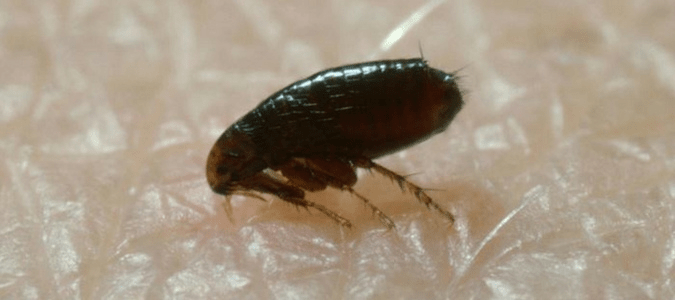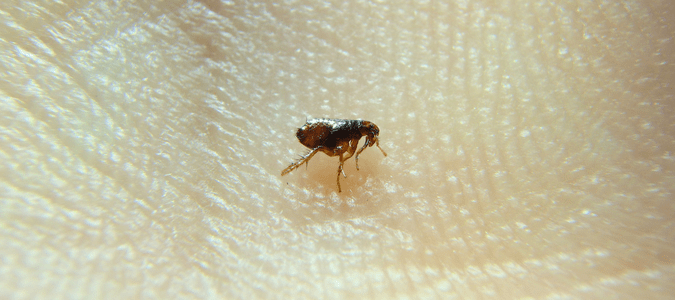Temperatures are rising, bringing more opportunities for outdoor activities and fun in the sun. It isn’t just people and pets that love to be outside and active in warmer weather. Fleas love it, too!
Fleas thrive when temperatures hover between 65-80 degrees and humidity sits between 75 percent and 85 percent. These pests are a summer problem in some parts of the country and almost a year-round menace for more southern states.
Different species of fleas can be found hopping around your home, your yard, your pets and you. You can find dog fleas, cat fleas, rabbit fleas and human fleas, named for the species’ preferred host. However, any type of flea can infest more than one kind of host.
How Do You Know Your Pet Has Fleas?
An obvious way to know Fido has fleas is if you see little dark specks in their fur or tiny brownish insects hopping around on them. Fleas don’t love the light, so check areas where they hide, such as your pet’s fur, belly or the inside of their thighs or ears.
What do fleas look like? If you see small pepper-like flecks that are sometimes called “flea dirt” on your dog, pick some off and scatter them on a wet paper towel. If the specks begin to look more like a bloodstain, then you can be sure that the specks are coming from fleas.
Other signs to look for include:
- Your pet is scratching more than usual.
- You notice your pet has some bald patches or sore areas on their skin.
- Unexplained scars appear.
- Red or irritated skin shows up.
- Skin in certain areas, such as around the edges of the ears, is thicker than in other areas.
- You or your family notice bites appearing on your own skin.
More About Fleas
Your pup can pick up fleas through contact with other animals that have an infestation or their surroundings. It’s easy for fleas to jump among hosts or from the outside environment onto an unsuspecting host because of their strong back legs. Contrary to popular belief, fleas do not fly because they do not have wings.
Fleas are more than an insect: They are external parasites. Other flea facts:
- Only adult fleas feed on their host’s blood. That is because adults have developed special mouthparts that they use to pierce skin and suck blood.
- One female flea can lay up to 1,500 eggs, depending on her lifespan. A flea can live from two weeks to a full year, with a female flea laying up to 50 eggs each day.
- Remember those strong legs mentioned above? Some kinds of fleas can jump more than 100 times the length of their bodies.
- Some types of fleas can leap more than a hundred times their own body length.
- The vast majority of flea eggs, larvae and pupae – about 95 percent – live in the environment instead of on your pets.
What Attracts Fleas
Besides the obvious lure of blood for their food, fleas also seek out a welcoming environment where they can lay eggs. As already mentioned, fleas need a specific range of temperatures and humidity to survive and thrive. The outdoors atmosphere can fluctuate a lot over the year, but people control the climate in their homes. This makes your space the perfect spot for fleas to move in and take over.
Fleas can even “cocoon” for months in an empty home, coming alive when a new family moves in with their dogs and other pets. But there are ways to get rid of the pests and make your family, including the fur babies, comfortable again.
Getting Rid of Fleas
If your pet has fleas, a good bath is a start, but it won’t solve the problem. Cleanliness plus the aid of a pest control professional for flea control is the winning combination. Learn more about how to get rid of fleas below.
Vacuuming well can be a great start. Get under the furniture, including cushions, and be sure to put the vacuum bags in the outdoor trash can frequently. Make sure you do a thorough job on any carpet in the home, as that is a prime place for the pests to hide. Fleas can stay alive in those bags and reinfest your home. Vacuuming can remove 30 percent of flea larvae and up to 60 percent of flea eggs that have taken up residence in your carpet.
Be sure to wash and change out your dog’s bedding regularly. Doing these in tandem helps ensure that a clean dog doesn’t immediately gain a new batch of fleas.
As far as the dogs go, start with a bath and a flea comb. Using a fine-toothed comb takes a while but it will pull the grown fleas out of the fur. Double-check those “hidden” areas like the face, neck and area around the front of the tail. To kill the fleas you remove, dip the comb in soapy water or an alcohol solution.
Once your furry friend is clean, use an insect growth regulator (IGR) to prevent a new infestation. You can find these products as sprays, pills or food additives. Check with your vet on what they recommend. Some products can take four to six weeks to get the flea infestation under control.
That timeframe can be a problem if your dog has a severe infestation. It can allow a re-infestation before you even kill off the initial batch. If that is the case, ask your veterinarian what product will work quickly to provide your pet some relief.
As you can see, it takes a delicate balance to clean the environment of early-stage fleas and remove adults from your pup. That is why it is best to call in the experts. A licensed pest control professional has various options for you depending on your lifestyle and specific concerns for your home. Talk to them about their recommendations and also about an ongoing plan to ensure your home and your dog stay flea free.
Do Fleas Bite More When They Are Dying?
When fleas come into contact with an anti-flea insecticide, they get active. Just as you would run away from a poison sprayed in your vicinity, the fleas want to get away as fast as possible.
This increased activity by the fleas might make your dog start itching more after application, and you might think you see more fleas on your dog’s skin. Never fear. That hyperactivity is just the fleas trying to escape death.
The insects might look like they are hopping off your dog and into your furniture or carpet or elsewhere in your home. This process means the fleas are in the process of dying. They will crawl around everywhere your dog sleeps – including in your bed – so you might see a sudden batch of them on your sheets or their bedding. Don’t worry. They are on their last legs at that point. And they don’t bite more during this process. The frantic activity is to save themselves, not to find one last meal.
It can take fleas up to 24 hours to die after your dog is treated. No product can keep the fleas from jumping onto a pet, but if your dog has been treated, those fleas will have a short stay.
Can Fleas Carry Diseases?
Fleas will, of course, irritate your dog and any family members who are unfortunate enough to get a bite and make everyone’s skin itchy. However, they can do much more to your dog, including:
- Start an allergic reaction. Some pets are very sensitive to fleas’ saliva.
- Blood loss. A large infestation can result in so much blood loss that your dog becomes anemic. Blood is flea food, and if young or frail dogs get a strong enough infestation, the blood loss can even be fatal.
- Introduce a tapeworm to your pet. Tapeworm eggs can infect flea larvae. If your dog eats such a larvae, it can become the parasite’s host. If your dog has fleas, be sure to talk to your vet about treating for worms, too.
- Pass along disease. Fleas that have fed on rodents or other diseased animals and then feed on your dog can infect your pup as well.
Many homeowners wonder if flea bites can make you sick. Fleas have caused the spread of disease for centuries. In 14th century Europe, one bacterium spread by fleas killed 25 million people in the “black plague.” Such diseases can also be passed onto dogs and other pets through the bite of an infected flea or through cuts and other abrasions that come into contact with the blood of infected animals or the waste of infected fleas.
These tiny pests can be more than an itchy menace. Fleas can cause real suffering for your dogs and real problems for you. Contact a licensed pest control professional to assess your home’s flea issues and help you develop a pest control plan to get rid of the fleas for good.
Trust ABC To Handle Your Flea Problem
Don’t let a flea problem in your home disturb you or your furry family members. ABC Home & Commercial Services’ pest control specialists have a proven track record of diagnosing pest problems and handling them effectively. Our team members can treat fleas both indoors and outdoors and any other pests that threaten your quality of life. We will do a thorough inspection and develop a plan that works for you, your family and your lifestyle, so you can enjoy spending time at home.



